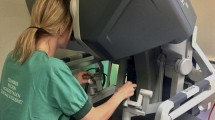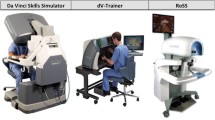Abstract
Background
The introduction of simulation into minimally invasive robotic surgery is relatively recent and has seen rapid advancement; therefore, a need exists to develop training curriculums and identify systems that will be most effective at training surgical skills. Several simulators have been introduced to support these aims—the daVinci skills simulator, Mimic dV-Trainer, Surgical Simulated Systems’ RoSS, and Simbionix Robotix Mentor. While multiple studies have been conducted to demonstrate the validity of these systems, studies comparing the perceived value of these devices as tools for education and skills are lacking.
Methods
Subjects who qualified as medical students or physicians (n = 105) were assigned a specific order to use each of the three simulators. After completing a demographic questionnaire, participants performed one exercise on the three simulators and completed a second questionnaire regarding their experience with the device. After using all systems, they completed a final questionnaire, which detailed their comparative preferences. The subject’s performance metrics were also collected from each simulator.
Results
The data confirmed the face, content, and construct validity for the dV-trainer and skills simulator. Similar validities could not be confirmed for the RoSS. >80 % of the time, participants chose the skills simulator in terms of physical comfort, ergonomics, and overall choice. However, only 55 % thought the skills simulator was worth the cost of the equipment. The dV-Trainer had the highest cost preference scores with 71 % of respondents feeling it was worth the investment.
Conclusions
Usability can affect the consistency and commitment of users of robotic surgical simulators. In a previous study, these simulators were objectively reviewed and compared in terms of their system capabilities. Collectively, this work will offer end-users and potential buyers a comparison of the perceived value and preferences of robotic simulators.







Similar content being viewed by others

References
Cameron JL (1997) William Stewart Halsted. Our surgical heritage. Ann Surg 225(5):445
Smith R, Truong M, Perez M (2014) Comparative analysis of the functionality of simulators of the da Vinci surgical robot. J Surg Endosc 29(4):972–983
McDougall EM (2007) Validation of surgical simulators. J Endourol 21(3):244–247
Hung AJ, Zehnder P, Patil MB (2011) Face, content and construct validity of a novel robotic surgery simulator. J Urol 186(3):1019–1024
Kelly DC, Margules AC, Kundavaram CR (2012) Face, content, and construct validation of the da Vinci Skills simulator. J Urol 79(5):1068–1072
Liss MA, Abdelshehid C, Quach S (2012) Validation, correlation, and comparison of the da Vinci Trainer(™) and the da Vinci surgical skills simulator(™) using the Mimic(™) software for urologic robotic surgical education. J Endourol 26(12):1629–1634
Lendvay Casale P, Sweet R, Peters C (2008) Initial validation of a virtual-reality robotic simulator. J Robot Surg 2(3):145–149
Kenney P, Wszolek M, Gould J, Libertino J, Moinzadeh A (2009) Face, content, and construct validity of dV-trainer, a novel virtual reality simulator for robotic surgery. J Urol 73(6):1288–1292
Sethi AS, Peine WJ, Mohammadi Y (2009) Validation of a novel virtual reality robotic simulator. J Endourol 23(3):503–508
Perrenot C, Perez M, Tran N, Jehl JP, Felblinger J, Bresler L, Hubert J (2012) The virtual reality simulator dV-Trainer® is a valid assessment tool for robotic surgical skills. J Surg Endosc 26(9):2587–2593
Korets R, Mues AC, Graversen JA, Gupta M, Benson MC, Cooper KL, Landman J, Badani KK (2011) Validating the use of the mimic dV-trainer for robotic surgery skill acquisition among urology residents. J Urol 78(6):1326–1330
Lee JY, Mucksavage P, Kerbl DC (2012) Validation study of a virtual reality robotic simulator—role as an assessment tool? J Urol 187(3):998–1002
Schreuder HWR, Persson JEU, Wolswijk RGH, Ihse I, Schijven MP, Verheijen RHM (2014) Validation of a novel virtual reality simulator for robotic surgery. Sci World J 2014:507076. doi:10.1155/2014/507076
Seixas-Mikelus SA, Kesavadas T, Srimathveeravalli G (2010) Face validation of a novel robotic surgical simulator. J Urol 76(2):357–360
Stegemann AP, Kesavadas T, Rehman S, Sharif M, Rao A, DuPont N, Shi Y, Wilding G, Hassett J, Guru K (2012) Development, implementation and validation of a simulation-based curriculum for robot-assisted surgery. Presented at the AUA poster session, May 19–23, 2012 Atlanta, GA
Hung AJ, Patil MB, Zehnder P (2012) Concurrent and predictive validation of a novel robotic surgery simulator: a prospective, randomized study. J Urol 187(2):630–637
Colaco M, Balica A, Su D (2012) Initial experiences with RoSS surgical simulator in residency training: a validity and model analysis. J Robot Surg 7(1):71–75
Finnegan KT, Meraney AM, Staff I (2012) da Vinci skills simulator construct validation study: correlation of prior robotic experience with overall score and time score simulator performance. J Urol 80(2):330–335
Connolly M, Seligman J, Kastenmeier A, Goldblatt M, Gould JC (2014) Validation of a virtual reality-based robotic surgical skills curriculum. Surg Endosc. doi:10.1007/s00464-013-3373-x
Lendvay TS, Brand TC, White L, Kowalewski T, Jonnadula S, Mercer LD, Khorsand D, Andros J, Hannaford B, Satava RM (2013) Virtual reality robotic surgery warm-up improves task performance in a dry laboratory environment: a prospective randomized controlled study. J Am Coll Surg 216:1181–1192
Raza SJ, Foghi S, Chowriappa A et al (2014) Construct validity of the key components of the fundamental skills of robotic surgery (FSRS) curriculum: a multi-institution prospective study. J Surg Educ 71(3):3126–3324
Tergas AI, Sheth SB, Green IC, Giuntoli RL 2nd, Winder AD, Fader AN (2013) A pilot study of surgical training using a virtual robotic surgery simulator. J Soc Laparoendosc Surg Soc Laparoendosc Surg 17:219–226
Lerner M, Ayalew M, Peine W, Sundaram C (2010) Does training on a virtual reality robotic simulator improve performance on the da Vinci® surgical system? J Endourol 24(3):467–472
Chowriappa A, Raza SJ, Stegemann A, Ahmed K, Shi Y, Wilding G, Kaouk J, Peabody JO, Menon M, Kesavadas T, Guru KA (2013) Development and validation of a composite grading and scoring system for robot-assisted surgical training: the robotic skills assessment scale. Podium presentation, AUA annual congress, San Diego
Culligan P, Gurshumov E, Lewis C, Priestley J, Komar J, Salamon C (2014) Predictive validity of a training protocol using a robotic surgery simulator. Female Pelvic Med Reconstr Surg 20:48–51
Van Nortwick S, Lendvay T, Jensen A, Wright A, Horvath K, Kim S (2010) Methodologies for establishing validity in surgical simulation studies. Surgery 147(5):622–630
Acknowledgments
The authors wish to thank the representatives of each simulator company for their assistance in collecting images: da Vinci skills simulator photos ©2013 Intuitive Surgical, Inc., used with permission; dV-Trainer Simulator photos ©2013 Mimic Technologies, Inc., used with permission; RoSS Simulator photos ©2013 Simulated Surgical Systems, LLC., used with permission; and Robotix Mentor photos ©2014 Simbionix USA, Corp., used with permission. This work is funded by U.S. Army Telemedicine and Advanced Technology Research Center. Grant #: W81XWH-11-2-0158.
Author information
Authors and Affiliations
Corresponding author
Ethics declarations
Disclosures
Alyssa Tanaka, Courtney Graddy, Khara Simpson, Manuela Perez, Mireille Truong and Roger Smith have no conflicts of interest or financial ties to disclose.
Rights and permissions
About this article
Cite this article
Tanaka, A., Graddy, C., Simpson, K. et al. Robotic surgery simulation validity and usability comparative analysis. Surg Endosc 30, 3720–3729 (2016). https://doi.org/10.1007/s00464-015-4667-y
Received:
Accepted:
Published:
Issue Date:
DOI: https://doi.org/10.1007/s00464-015-4667-y



